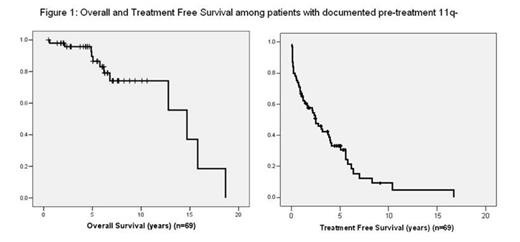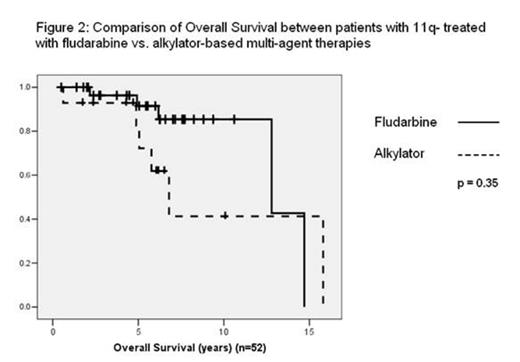Abstract
BACKGROUND
The 11q22.3 deletion (11q-) encompassing the ATM locus detected by fluorescence in situ hybridization (FISH) is present in up to 20% of CLL patients (pts), and is associated with an aggressive disease course and poor response to treatment (tx). However, there are few clinical studies that have specifically focused on pts with 11q-. Prognostic factors that may explain the variable outcome in this group have not been investigated, nor have survival outcomes in a population-based setting. Furthermore, few clinical studies have described practice patterns within the 11q- group. This study aims to improve our understanding of the prognosis, management and clinical course of CLL pts with 11q-.
METHODS
The BC Provincial CLL Database, which includes all pts who have undergone CLL FISH testing in a provincially validated laboratory since 2004, was used to identify all pts in BC (population 4.5 million) with a confirmed 11q- >10% found at any point during the disease course, with or without other detectable FISH abnormalities. Overall survival (OS), treatment-free survival (TFS) (time from diagnosis to first tx/death) and time to second-line treatment (tx) were the main outcomes of interest, and were investigated in relationship to age (<60 vs ≥60 years [yrs]), sex, Rai stage (3-4 vs 0-2), CD38 status, % 11q-, and presence of other recurrent FISH abnormalities (17p deletion [17p-], trisomy 12, 13q deletion, and IGH translocation). Multivariate analysis (MVA) was performed using Cox proportional hazard models with a backwards stepwise selection process to determine predictors of OS/TFS.
RESULTS
125 out of 1044 (12%) pts were identified with 11q- detected at any point. Median age at CLL diagnosis was 61 yrs (range, 35-80). At a median follow-up of all patients of 6.3 yrs (range 0.5 - 26.2), median OS and TFS for the entire cohort are 12.6 yrs (standard error [SE] = 1.5 yrs) and 2.5 yrs (SE = 0.5 yrs), respectively. In MVA, advanced Rai stage (HR 3.7, 95% CI 1.28-10.8, P=.015), age ≥ 60 yrs (HR 2.2, 95% CI 1.2-4.3, P=.012) and male gender (HR 2.4, 95 % CI 1.5-5.3, P=.024) were significant predictors of OS.
Clonal evolution (CE) to 11q- and/or other FISH abnormalities was documented in 12 pts. In 9/12 cases, 11q- developed after one or more tx courses whereas, in 3/12 cases, 11q- developed prior to tx initiation at median 5 yrs (range, 3.8-6.5) from initial FISH test.
Sixty-nine pts had a documented 11q- pre-tx. At median follow-up of 5.0 yrs (range, 0.5 to 18.7), this group had median OS and TFS of 14.7 (SE =1.8) and 2.5 yrs (SE= 0.5), respectively (Fig 1). Pts with presence of 11q- and 17p- had a markedly worse prognosis compared to those without, with median OS 4.9 vs. 14.7 yrs (P< .001) and TFS of 0.2 vs. 2.5 yrs (P=0.31). In MVA, co-presence of 17p- (HR = 11.3, 95% CI 2.4-52.5, P=.02) and age ≥ 60 yrs (HR 3.8, 95% CI 0.83-17.1, P=.05) were adverse prognostic markers for OS. Age ≥ 60 yrs (HR =2.0, 95% CI 1.0-3.9, P=.03), presence of > 75% 11q- (vs. < 75 % 11q-) (HR = 1.8, 95%CI 1.0-2.3, P=.03) and advanced Rai stage (HR = 7.1, 95%CI 2.4-21.0, P=.01) were associated with shorter TFS.
Of this group of 69, 52 pts (75%) received at least one tx course during follow-up. Thirty-three pts received fludarabine +/- rituximab (FR) as first line, 14 pts received alkylator based tx (FC +/- R in 8; CVP +/- R in 5; CHOP + R in 1) and 5 pts received chlorambucil-based +/- R. Pts treated with FR alone had median OS 12.8 yrs (SE=1.0), which was not statistically different from those treated with alkylators , where median OS was 6.8 yrs (SE=2.1), P=.35 (Fig 2). In MVA, receipt of fludarabine vs alkylator-based treatment was not associated with any significant difference in OS (P=.52) or time to 2nd tx (P=.65).
CONCLUSION
This study is to our knowledge the largest population-based report of CLL pts with 11q- and further enhances our understanding of the clinical course of such pts in a real world setting. Although median TFS of 11q- pts is short at 2.5 yrs, OS remains long at 12.6 yrs. The importance of combined 11q- and 17p- as adverse prognostic markers in CLL is highlighted. Most pts in BC with 11q- received FR as first line therapy. There is retrospective trial data suggesting that first line tx containing alkylators (ie. cyclophosphamide) can overcome the adverse prognostic features of 11q-. However, most of this trial data is from the pre-R era. Though limited in numbers, our study does not suggest that first line tx without alkylators is associated with negative outcomes.
Toze:Roche: Consultancy, Honoraria, Research Funding. Gerrie:F Hoffmann-La Roche: Other.
Author notes
Asterisk with author names denotes non-ASH members.



This feature is available to Subscribers Only
Sign In or Create an Account Close Modal